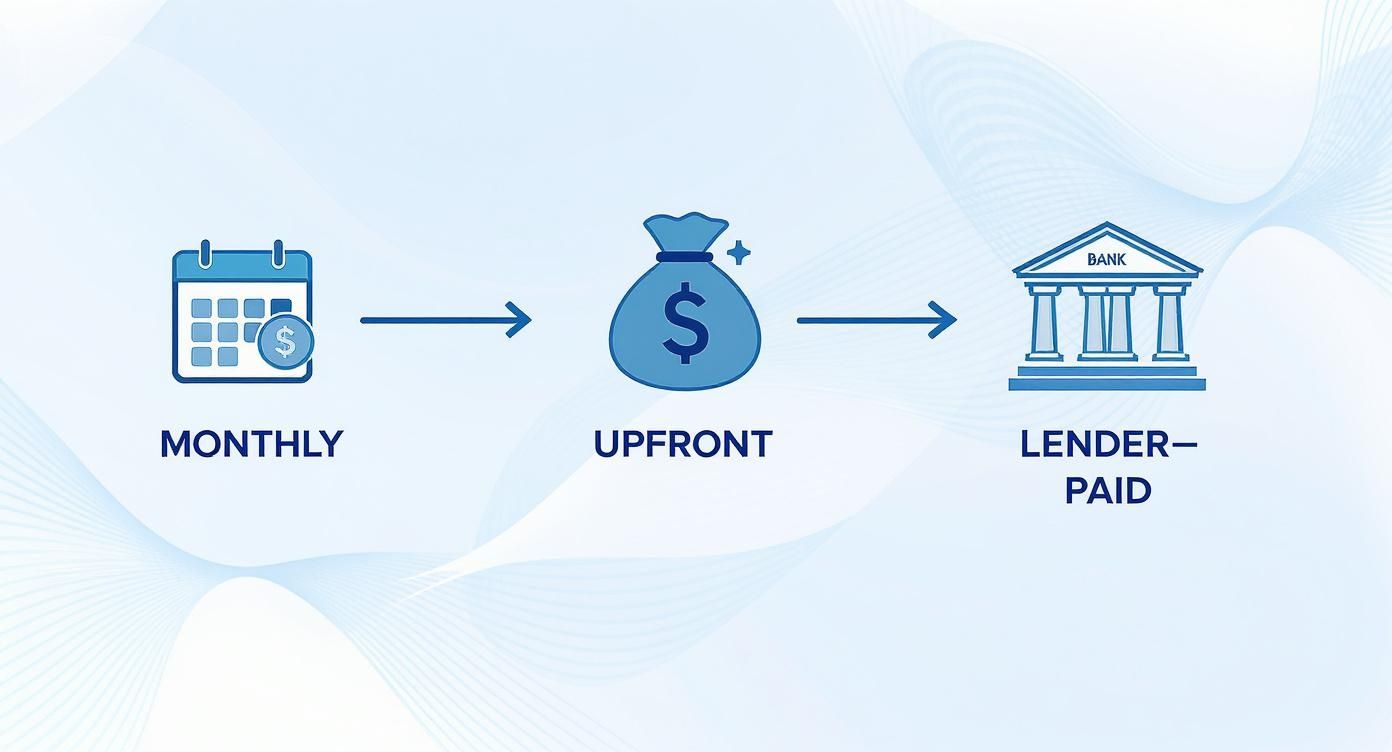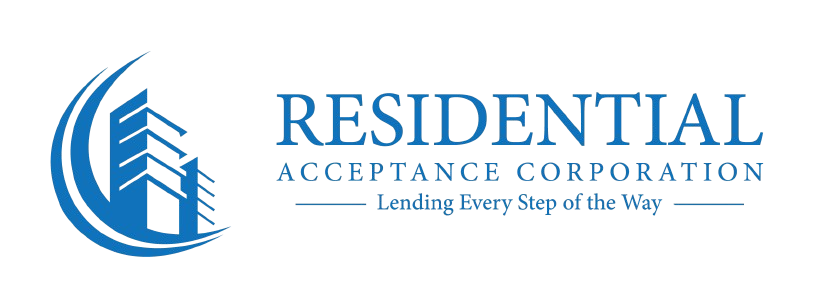If you've started looking into home loans in Tampa, you've almost certainly come across the term Private Mortgage Insurance, or PMI. It might sound like just another piece of mortgage jargon, but it's actually a key that can unlock the door to owning a home much sooner than you might think.
A Clear Guide to Private Mortgage Insurance
So, what is it? Simply put, PMI is a special type of insurance policy that makes it possible to buy a home with a down payment of less than 20%. It’s a very common part of the homebuying journey, especially for first-time buyers here in Tampa.
The crucial thing to understand is that PMI primarily protects your mortgage lender, not you. Lenders prefer a 20% down payment because it gives you, the borrower, a significant amount of equity in your home right from the start. This skin in the game acts as a safety net for them. If something goes wrong and you can't make your payments, they're more likely to get their money back when the home is sold.
When your down payment is smaller, the lender takes on more risk. That's where PMI steps in.
Bridging the Down Payment Gap
PMI exists to offset that extra risk for the lender. When you pay your monthly PMI premium, you’re covering the cost of an insurance policy that protects them. This protection gives them the confidence to approve a loan they might otherwise see as too risky, letting you buy a home with as little as 3-5% down.
This setup is a huge part of the American housing market. The private mortgage insurance industry has opened the doors to homeownership for over 38 million borrowers since it began. In 2024 alone, it helped more than 800,000 homebuyers get into homes, and about 65% of them were buying for the very first time.
To really get it, it helps to understand how insurance fundamentally works as a way to manage risk.
The crucial takeaway is this: PMI is not a penalty for a small down payment. Instead, it is the tool that makes low-down-payment mortgages possible, turning a potential barrier into a clear stepping stone toward owning your Tampa home.
This quick table breaks down the essentials of PMI to make it even clearer.
PMI at a Glance for Tampa Homebuyers
| Key Aspect | Simple Explanation | What This Means for You |
|---|---|---|
| What It Is | An insurance policy for your lender. | It protects the lender, allowing them to approve your loan with a small down payment. |
| Who Pays | You, the homebuyer. | The cost is usually added to your monthly mortgage payment. |
| Why It's Needed | When you put down less than 20%. | If you have a smaller down payment, expect to have PMI. |
| The Goal | To get rid of it as soon as you can. | Once you have 20% equity, you can start the process of removing PMI and lowering your payment. |
Ultimately, PMI is a means to an end—getting you into your dream home faster.
At Residential Acceptance Corporation (RAC Mortgage), we guide local Tampa buyers through this common requirement every day. We make sure you understand every line item in your loan. The relationship between your down payment and loan amount is called the loan-to-value ratio, and it's what determines if you need PMI. You can dive deeper into how it's calculated in our guide on the loan-to-value ratio explained.
Our goal is simple: to make the process transparent and help you secure your home with total confidence.
When you're sorting through the costs of buying a home in Tampa, one fee often stands out: Private Mortgage Insurance. You might be wondering, "If I'm the one paying for it, why does my lender need it?"
It’s a great question, and the answer is simple: PMI protects the lender, not you.
Protecting the Lender Against Risk
Think about it from your lender's point of view. A mortgage is a massive financial risk for them. When a buyer puts down a traditional 20%, they instantly have a lot of skin in the game—a big chunk of equity. That equity acts as a buffer for the lender. If the worst happens and the borrower defaults, the lender can sell the home and is much more likely to get their money back.
But when you put down less than 20%, that buffer shrinks, and the lender's risk shoots up. This is where PMI steps in. It’s a safety net that pays the lender back if a borrower can’t make their payments and the home ends up in foreclosure.
This insurance is the very thing that gives lenders the green light to approve loans with smaller down payments. Say you find the perfect condo in Tampa's Channelside district but you only have 10% saved up. Without PMI, most lenders would walk away, seeing the loan as too risky. With PMI, that risk is managed, making your homeownership dream possible.
PMI isn't a punishment for a small down payment. Think of it as the key that unlocks the door to homeownership for you much, much sooner. It gets you in the game and building equity without having to spend years saving up a huge lump sum.
The PMI Relationship Explained
This setup creates a three-way relationship: you, your lender, and the PMI company. You pay the monthly premium, which buys an insurance policy that covers your lender's back. This structure is a fundamental part of the mortgage world today, particularly for conventional loans—a very common choice for homebuyers. You can dig deeper into the differences between FHA and conventional loans to understand why this matters.
And it’s a huge part of the market. The global private mortgage insurance industry is expected to reach $55 billion USD by 2025. Lenders across the country require it on nearly every conventional loan with less than 20% down. So, if you're in that boat, you can expect it to be a standard part of the process.
At Residential Acceptance Corporation (RAC Mortgage), we see it as an incredibly useful tool that helps Tampa residents get into their homes and start their new lives faster.
Calculating the Cost of PMI in Florida
Okay, so you understand that you might need Private Mortgage Insurance. But what does that actually mean for your wallet? Let's make this tangible and figure out how much PMI will really add to your monthly mortgage payment here in Florida.
The cost isn't just some random number your lender picks. It's a calculated percentage of your total loan amount. While every situation is different, a solid rule of thumb is to expect your annual PMI premium to be somewhere between 0.5% and 1% of what you originally borrowed. That yearly total gets divided by 12 and tacked right onto your monthly mortgage bill.

While it's definitely an extra expense, this is the very tool that has opened the door to homeownership for millions of Americans who started with smaller down payments of 3% or 5%. It's just crucial to remember that PMI is there to protect the lender from potential losses, not you, the borrower.
A Tampa Home Example
Let's break it down with a real-world Tampa scenario to see how the numbers play out. Imagine you’ve found the perfect place for $350,000 and you're putting down 10%, which is $35,000.
- Loan Amount: $315,000
- PMI Rate (Example): 0.7% annually
- Annual PMI Cost: $315,000 x 0.007 = $2,205
- Monthly PMI Cost: $2,205 / 12 = $183.75
In this case, your PMI would add roughly $184 to your mortgage payment each month. This little calculation shows just how a tiny percentage can translate into a real monthly cost, which is absolutely vital to know for accurate budgeting.
Key Factors That Determine Your PMI Rate
Your PMI rate isn't set in stone. It's actually based on how much risk the lender thinks they're taking on. If you can strengthen your financial profile in a few key areas, you can often snag a lower premium and save some serious cash.
The two biggest things that will move the needle on your PMI rate are your credit score and the size of your down payment. A great credit score and a larger down payment show the lender you're a lower risk, which almost always gets you a better rate.
But other factors come into play, too:
- Your Credit Score: A higher score is proof of responsible borrowing habits and can dramatically lower what you pay for PMI.
- Down Payment Size: While anything under 20% down usually requires PMI, putting down 15% is going to look a lot better—and get you a better rate—than putting down only 5%.
- Loan Type: The specifics of your mortgage, like whether it's a fixed-rate or an adjustable-rate loan, can also influence the cost.
It’s worth noting that your credit history impacts more than just your mortgage. It's helpful to understand how your credit rating can influence insurance rates across the board.
This is where working with an expert broker like Residential Acceptance Corporation (RAC Mortgage) really pays off. We can dive into your complete financial picture and give you straight-up advice on how to make your application as strong as possible. Our goal is to help you secure the lowest PMI rate you can get, potentially saving you a ton of money over the life of your loan.
Exploring Your Different PMI Payment Options
When it comes to Private Mortgage Insurance, a lot of homebuyers in Tampa assume it’s just a standard, unavoidable fee. But here’s the good news: you’ve got options. How you structure your PMI payments can actually make a real difference in your monthly budget and long-term financial picture.
Understanding these choices is the first step. This isn't a one-size-fits-all deal; the best path for you really depends on how much cash you have on hand, how long you see yourself staying in the home, and what your financial goals are.
Borrower-Paid Monthly PMI (BPMI)
This is the one most people are familiar with. With Borrower-Paid Monthly PMI (BPMI), the premium is simply divided by 12 and rolled into your mortgage payment each month. You’ll see it right there as a line item on your statement, which makes it super easy to track.
The biggest plus here is that you don't have to come up with a big chunk of cash at closing. Because it’s a monthly expense, it’s often the most manageable choice for first-time buyers who are already juggling a down payment and moving costs. Better yet, once you’ve built up 20% equity in your home, you can ask to have it removed, and it automatically drops off when your loan-to-value ratio hits 78%.
Lender-Paid and Single-Premium PMI
Beyond the classic monthly payment, there are a couple of other routes you can take: Lender-Paid PMI and Single-Premium PMI. They work quite differently and are suited for different kinds of borrowers.
- Lender-Paid PMI (LPMI): With this setup, the lender "pays" the insurance for you. In reality, they do this by giving you a slightly higher interest rate for the entire life of the loan. This can lower your total monthly payment, which is appealing, but the catch is that you can't cancel it. That higher rate is permanent unless you decide to refinance down the road.
- Single-Premium PMI: This option involves paying the entire PMI premium in one lump sum. You can either pay it out-of-pocket at closing or finance it into your total loan amount. Paying it all at once can save you money in the long run compared to the monthly plan, but it obviously requires having a significant amount of cash ready to go.
Choosing the right PMI structure is a strategic financial decision. It’s about balancing your immediate monthly costs against your long-term savings and homeownership plans.
To make things a bit clearer, we've put together a quick comparison to help you weigh your options.
Comparing Your PMI Options
This table breaks down the key differences between the main types of Private Mortgage Insurance to help you see which one might be the best fit for your situation.
| PMI Type | How It's Paid | Best For Borrowers Who… | Potential Drawback |
|---|---|---|---|
| BPMI | Monthly, as part of your mortgage payment. | Want to minimize upfront costs and plan to cancel PMI in the future. | Can result in a higher total monthly payment initially. |
| LPMI | Through a higher interest rate on your loan. | Want the lowest possible monthly payment and are comfortable with a higher rate. | Cannot be canceled; requires refinancing to remove the higher rate. |
| Single-Premium | One large lump sum at closing. | Have extra cash on hand and want to avoid a monthly PMI payment. | Requires a significant amount of money upfront. |
Navigating these choices is exactly where having an expert partner like Residential Acceptance Corporation (RAC Mortgage) makes a difference. We can run the numbers for your specific scenario right here in Tampa, helping you pick the payment structure that fits your goals perfectly. If you’re looking to buy with less money down, checking out a low down payment mortgage in Tampa can also give you some great options to consider.
How to Cancel PMI on Your Tampa Home Loan
That Private Mortgage Insurance payment you make every month? It’s not meant to be a permanent fixture of your mortgage. Think of it as a temporary necessity, a means to an end. For Tampa homeowners, the great news is there's a clear path to getting rid of it, which translates directly into lower monthly payments and some serious savings over the life of your loan.
It all boils down to one word: equity.
Equity is the slice of your home you actually own—the difference between what it's worth on the market and what you still owe on the loan. Once you hit the magic number of 20% equity, you're officially in the driver's seat and can start the process of kicking PMI to the curb.
Reaching the 20% Equity Threshold
So, how do you get to that 20% milestone? There are a few ways to build equity in your Tampa home, each with its own timeline.
- Standard Loan Payments: This is the slow and steady route. Every single month, a part of your mortgage payment chips away at your principal loan balance. Over time, these payments naturally build your ownership stake.
- Strategic Extra Payments: Want to get there faster? Making extra payments directly toward your principal is a game-changer. Even throwing an extra $100 a month at your loan can dramatically speed up your equity growth and get you to that 20% mark way ahead of schedule.
- Home Value Appreciation: Sometimes, the Tampa real estate market does the heavy lifting for you. As property values in your area climb, your home becomes more valuable, boosting your equity without you having to do a thing.
Once your loan-to-value (LTV) ratio hits 80%—which is just another way of saying you have 20% equity—you can formally ask your lender to cancel your PMI. Taking this step puts you back in control of your mortgage costs.
The Cancellation Process Explained
Removing PMI is a pretty straightforward process. Thanks to a federal law called the Homeowners Protection Act, you have the right to request cancellation as soon as you hit that 80% LTV mark.
The catch? You have to make the request in writing, be up-to-date on your payments, and have a solid payment history. Your lender might also ask for a new appraisal to verify your home's current market value, especially if rising property values are the main reason you've reached 20% equity.
But what if you forget to ask? The law has a built-in safety net. Lenders are required to automatically terminate PMI once your LTV is scheduled to reach 78% based on your original loan schedule.
The way you pay for PMI—monthly, upfront in a single premium, or through a lender-paid plan—can also affect how you get rid of it. This infographic breaks down the options.

As the visual shows, your payment structure matters. Generally, only the monthly premium option is cancelable, which is what most homeowners have.
Knowing exactly when to make your move is key. Timing your cancellation request just right can save you hundreds, if not thousands, of dollars. Here at Residential Acceptance Corporation (RAC Mortgage), we can help you figure out where you stand with your equity and pinpoint the perfect time to contact your lender. Our goal is to make sure you don't pay a single dollar more in PMI than you absolutely have to.
Your Tampa PMI Questions Answered
We've covered the basics of private mortgage insurance, but let's be real—the details are where the real questions pop up for Tampa homebuyers. Getting straight answers can make all the difference, giving you the confidence to move forward.
Here are a few of the most common questions we hear every day.
Do VA or FHA Loans Require PMI?
Nope, but this is a common mix-up. Private Mortgage Insurance (PMI) is a term specifically for conventional loans.
Government-backed loans have their own versions. FHA loans, for instance, have a Mortgage Insurance Premium (MIP), which can stick around for the entire life of the loan. VA loans typically skip monthly insurance and instead have a one-time "VA funding fee."
Here at Residential Acceptance Corporation (RAC Mortgage), we can walk you through the pros and cons of each, helping you see which loan makes the most sense for your wallet here in Tampa.
Can I Use a Second Mortgage to Avoid PMI?
Yes, you absolutely can. This strategy is often called a "piggyback loan," and it's a savvy move for the right buyer.
Here's how it works: you take out a primary mortgage for 80% of the home's price, put 10% down in cash, and then cover the remaining 10% with a second, smaller mortgage. Because your main loan is at that magic 80% loan-to-value ratio, you sidestep PMI altogether.
It's a great option, but you have to weigh the interest rate on that second loan against what you would have paid for PMI. The experts at RAC Mortgage can run the numbers both ways to show you the clear winner.
A piggyback loan can be a smart move, but it's crucial to weigh the long-term costs. Comparing the fixed cost of a second mortgage to the temporary cost of PMI is key to making the right decision for your financial future.
Can I Cancel PMI Sooner if My Tampa Home Value Goes Up?
You bet. This is one of the biggest perks of living in a hot market like Tampa. If home values in your neighborhood shoot up, your equity grows right along with them.
Once you feel confident you've hit at least 20% equity thanks to that appreciation, you can officially ask your lender to cancel your PMI.
They’ll almost certainly require a new appraisal to verify the home's current market value. We at RAC Mortgage can help you figure out the right time to make that call and how to approach your lender for the best shot at success.
Is Lender-Paid Mortgage Insurance a Better Deal?
It can be, but you have to look closely. With Lender-Paid PMI (LPMI), you don't have a separate PMI line item on your monthly statement. Instead, the lender rolls the cost into your loan by giving you a slightly higher interest rate.
This often leads to a lower total monthly payment, which feels great upfront. The catch? You can't just cancel it once you hit 20% equity. That higher interest rate is locked in for the long haul unless you refinance the entire mortgage.
Let RAC Mortgage help you compare the lifetime cost of both options. We'll show you exactly which path saves you the most money over time.
Figuring out the nuances of private mortgage insurance and finding the right loan can feel like a maze, but you don't have to navigate it by yourself. The dedicated team at Residential Acceptance Corporation is here to give you clear answers and expert guidance for your Tampa homebuying journey.

